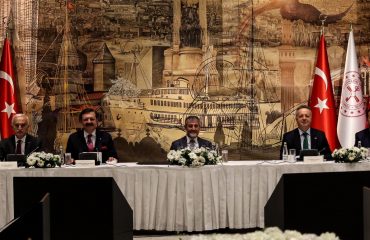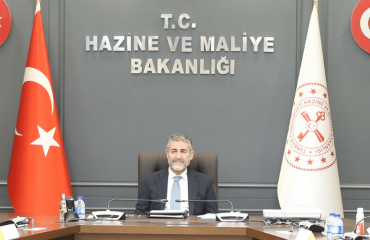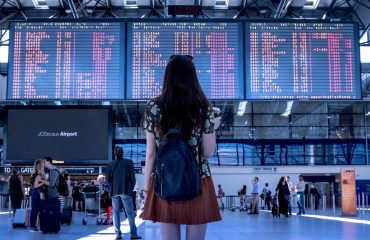
Turkish and American soldiers have finally begun their joint patrol on the Syrian side of the border as of September 8, 2019, but according to President Tayyip Erdoğan, this was far from being sufficient. On the same day in the eastern city of Malatya, where a major U.S./NATO radar is based, he stated that “Our ally is trying to create a safe zone, not for us but a terrorist organization”, implying the outlawed Kurdistan Workers’ Party (PKK); “If we cannot establish a safe zone controlled by our soldiers before September ends, we’ll have no choice but to go our way”, meaning another military operation into Syria.
Almost at the same time in Istanbul, U.S. Secretary of Commerce Wilbur Ross had given a pause to his three-day talks with his Turkish counterpart Ruhsar Pekcan and private sector representatives to pay a visit to the Greek Orthodox Patriarch Bartholomeos. But this wasn’t the last of Ross’s contacts; he is scheduled to leave Turkey after having a meeting with President Erdoğan on September 10 in Ankara.
It is unforeseen, even under normal circumstances, that an American Secretary of Commerce having a working visit of five days in Turkey. It is particularly extraordinary given that NATO allies Turkey and the U.S. are in the middle of one of their most serious crises due to the purchase of Russian S-400 missiles by Turkey and the U.S. starts “unwinding” Turkey from the F-35 co-production program in retaliation. U.S. President Donald Trump’s decision to send Ross to Turkey for such a long duration, while Congress demands CAATSA economic sanctions on Turkey, is plausibly aimed at increasing the trade volume between the two countries to $100 billion (a fivefold rise from the current $20 billion).
This is not only due to Turkey’s strategic importance in the eyes of Trump (despite Congress objections). It is also not only due to his wish to render Turkey dependent on closer cooperation with Russia, Iran and China. Trump also thinks that boosting trade with Turkey is in American interests in his trade war with China, which is probably the most strategically important issue for him nowadays.
Indeed, Ross brought up the China issue during the meeting between Turkish and American trade committees held at the Dolmabahçe Palace on September 7, sources who wanted not to be named told YetkinReport. He reportedly said that the U.S. would encounter exportation problems with China due to the increase of customs duties and that Turkey could swiftly enter that market to sell goods to the U.S.
Minister Pekcan’s listing of civil aviation, automotive, jewelry, furniture and textile sectors, corresponds to the Chinese goods which will likely be in shortage in the American market once Trump’s tariffs are in action; she stressed that such a trade with the U.S. should be on “equal and fair” terms.
In summary, Trump wishes to obstruct Chinese exports and instead import the goods that the American market needs from countries like Turkey, which provide cheap and qualified workforce; not only from Turkey but including Turkey. Of course, the U.S. does have its conditions in this deal, notably in the weapons sector, the pharmaceutical industry, agriculture and food industry. Last but not least, there is the demand that Turkey starts buying American liquefied natural gas (LNG) instead of natural gas from Russia and Iran.
The timing with which Trump sent Ross to Turkey is meaningful. If they manage to make headway in the talks, Congress will be told on September 9, when summer recess is over and work resumed, that economic sanctions imposed on Turkey will be a conflict of interest for the U.S. It will also prove to Erdoğan that economic sanctions can be stopped if American economic interests are met. That’s also partly why Mehmet Ali Yalçındağ, president of the Turkey-U.S. Business Council (TUBC), who played a major role in opening up a trade-diplomacy channel between the two countries, thinks the ambitious goal of ﹩100 billion in 2023 is reachable “provided that the strong will of Turkish and American leaders prevails”. The fact that Ross co-presided the TUBC board meeting shows that he gives as much importance to the relations with the private sector as with the government
Erdoğan, on the other hand, worries that if he agrees with Trumps “trade solves all” approach without concrete measures concerning a “safe zone” against the PKK’s Syria branch the PYD, the diversional attitude towards the Syria situation might carry on. This is the reason why he’s set the date for the end of September; he wants to guarantee the safe zone before Congress tackles Turkey again.
Another dimension will be added to this topic with the Astana Process talks on September 16. During this meeting, Erdoğan will discuss the current problems in Syria and Syria’s future with Russian Head of state Vladimir Putin and Iran’s President Hassan Rouhani. Erdoğan had already paid a visit to Moscow on August 27 to express once more that he did not have his eye on Idlib or any other Syrian territory, following attacks by the Syrian army which put the security of Turkish military monitors around Idlib in jeopardy. Erdoğan had also tried to convince Putin that the Safe Zone they were looking to install East of Euphrates did not mean Turkey was claiming Syrian territory, and it was upon this that Putin backed Erdoğan’s efforts with Trump on the Safe Zone issue.
There is an equation with multiple variables at hand. There is now a new addition to this equation, which until now was confined to the Safe Zone issue in Syria: the trade aspect. Could this new element help Turkey put its relations with the U.S., with Russia and with Syria on the right track? It appears that we’ll need to wait until the end of September to find out.


